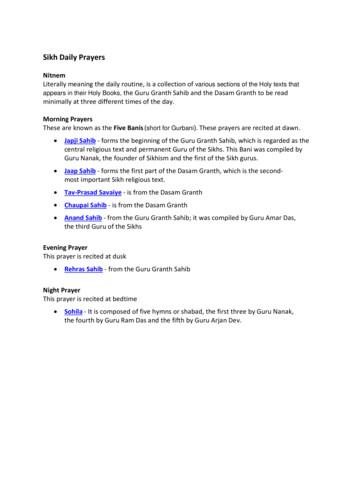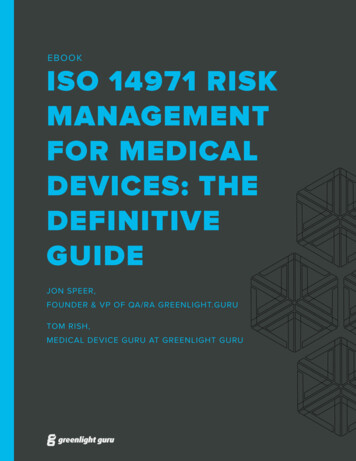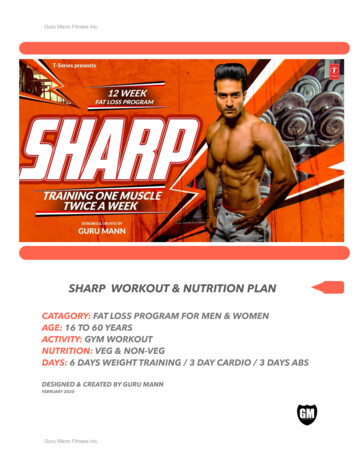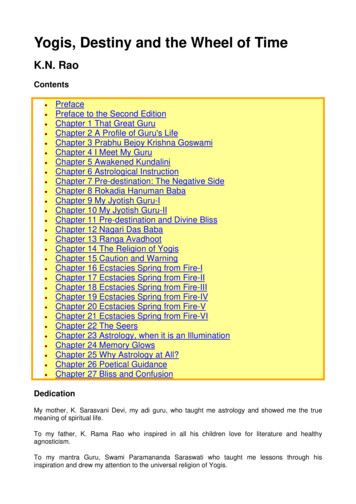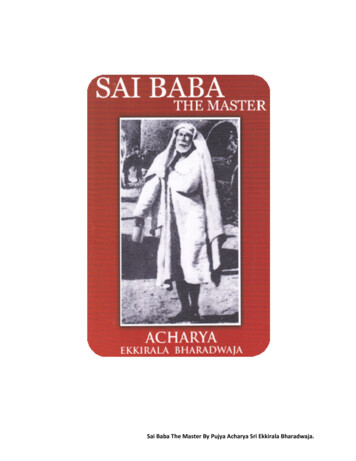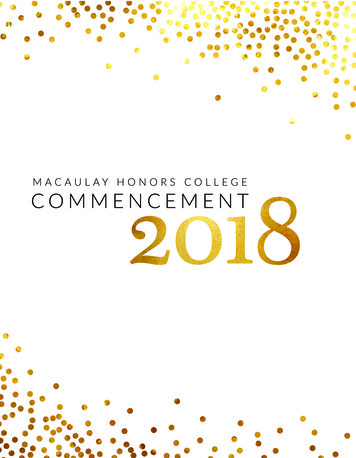
Transcription
GURU NANAK COLLEGE (AUTONOMOUS)(Affiliated to University of Madras and Re-Accredited at ‘A’ Grade by NAAC)Guru Nanak Salai, Velachery, Chennai – 600042.M.Phil. Zoology(SEMESTER PATTERN WITH CHOICE BASED CREDIT SYSTEM)Syllabus(For the candidates admitted in the Academic year 2020-21 and thereafter)
VisionTo instill the scientific dogmas of nature; to provoke the interest towards learning scienceand allied subjects; to equip the students with scientific skills to acquire competency needed foremployment; to inculcate professional ethics and value-based education to improve socio-economicstatus; to impart interdisciplinary approach for identifying and solving real world scientificproblems through research.Mission To facilitate an encouraging and exciting environment to develop the scientific temper instudents through a curriculum based on fundamental as well as advanced scientificknowledge. To provide technical skills in the respective disciplines through conducting practicaltraining including internship as well as project, this will hone the skills necessary to becomea successful mathematician, physicist, chemist, biotechnologist and visual communicationprofessional. To inculcate interdisciplinary knowledge, elective subjects in various fields are offered,thereby providing an opportunity to the students to identify their interest towards aparticular field and pursue the passion.
PROGRAMME OUTCOMEPO 1: Acquire a comprehensive knowledge of research methodology and gain the skills to teachbasic and advanced concepts in life sciences.PO 2: Demonstrate the ability to engage in critical, independent, and creative thinking.PO 3: Understand how scientific knowledge grows, and is organized, evaluated and disseminated.PO 4: Demonstrate the ability to connect and apply biological knowledge to other disciplines andto integrate knowledge into their personal and professional lives.PO 5: Acquire the practical skills and ability to perform experiments and analyses to obtainaccurate results and thus gain the ability to solve problems.PROGRAM SPECIFIC OUTCOMEThe course endeavors to:PSO 1 :Be proficient at critical thinking, annotation and communication of scientificinformation and able to succeed in competitive examinations like CSIR – NET, UGCNET in Life Sciences, SET – Tamil Nadu, and interviews.PSO 2 :Acquire cognitive and hands-on skills in advanced scientific methods in DNAFingerprinting techniques, cytological techniques, drug designing and stem cell biologyused for identification and analytical purposes in animal sciences research. Be able toidentify and apply the recent advances in animal sciences for the improvement of thestandard of living through its application in medicine, agriculture, pharmacology,aquaculture, aquarium fishes and entomology and other relevant fields.
GURU NANAK COLLEGE (AUTONOMOUS)VELACHERY, CHENNAI – 600 042M.Phil., ZOOLOGYCOURSE STRUCTURE for 2020 – 2021 BatchSemester PartSubjectsCreditExam hoursExt. Max MarksPaper IResearch Methodology53100Paper IIRecent Advances InZoology53100Paper IIICrustacean Endocrinologyand Reproduction53100ProjectWorkDissertation21-300I & IITotal36The assignment of marks for Project is as follows:(1.) Continuous Internal AssessmentLiterature survey, Methodology and Results of the project work - 80 marks(2.) End Semester AssessmentProject work book - 70 marksDissertation - 150 marks
M.PHIL SYLLABUSPaper –IRESEARCH METHODOLOGYSUBJECT CODE : 16LZOOC01SEMESTER: I & IITHEORYCREDITS: 5MARKS 100Total No of Hours: 180COURSE OBJECTIVES:To describe the principle, working mechanism and applications of various instrumentsused in research laboratory and to comprehend the central concepts of modern statisticaltheory and their probabilistic foundation.1. Principles and application of Light, Phase Contrast, Fluorescence, Scanning andTransmission Electron Microscopy, Cytophotometry and Flow Cytometry, Fixation andStaining.(25 Hrs)2. Principles and Applications of Gel Filtration, Ion-exchange and Affinity, HPLCChromatography, Electrophoresis, Electro-Focusing, Ultra Centrifugation (Velocity andBuoyant Density) ELISA.(25 Hrs)3. Principles and Techniques of Nucleic Acid Hybridization and Cot Curves, Sequencing OfProteins and Nucleic Acids, Southern, Northern and Western Blotting Techniques, Dot andSlot blot, Polymerase Chain Reaction, DNA Foot Printing, Screening of Genomic ANDcDNA Libraries.(30 Hrs)4. Principles of Bio-physical Methods for Biopolymer Structure, Determination of X-raydiffraction, Fluorescence, UV, ORD/CD Visible, NMR & ESR Spectroscopy,Hydrodynamic methods, Atomic Absorption and Plasma Emission Spectroscopy.(30 Hrs)5. Principles and Application of Tracer Techniques in Biology, Radiation Dosimmetry,Radioactive Isotopes and Half-life of isotopes, Autoradiography, Cerenkov radiation,Liquid scintillation spectrometry.(25 Hrs)6. Principles and Practice of Statistical Methods in Biological Research, Samples andPopulation, Basic Statistics, Average Statistics of Dispersion, Co-efficient of Variation,Standard Error, Confidence Limits.(25 Hrs)7. Probability Distribution (Binomial, Poisson and Normal Tests of Statistical Significance,Simple Correlation and Regression, Analysis of Variance).(20 Hrs)
References:1. Alka Prakash. Laboratory manual of Entomology. New Delhi, New Age International,2001.2. Kothari, C.R. 2004. Research Methodology: Methods and Techniques. New AgeInternational Publishers, Chennai.3. Plummer, D.T. 1971. An Introduction to Practical Biochemistry. McGraw-Hill BookCompany. London.4. Nigel Strok – Biodiversity Assessment5. G.S. Sandhu. Research Techniques in Biological Sciences.6. Palanichamy, S and Manoharan, M. 1994. Statistical Methods for Biologists, PalaniParamount Publications. Palani.7. Biochemical Methods- Sadasivam and Manickam.Question paper pattern:SectionSection AQuestion ComponentEssay Answer any 5 outof 10 questionsNumbers1 - 10Marks20Total MarksTotal100100Distribution of QuestionsSectionSection AUnits1234567No of QuestionsTheoryProblems112111111
Paper –IIRECENT ADVANCES IN ZOOLOGYSUBJECT CODE : 16LZOOC02SEMESTER: I & IITHEORYCREDITS: 5MARKS 100TOTAL NO OF HOURS: 180COURSE OBJECTIVES:To describe the fundamental molecular principles of classical and modern genetics and tocomprehend the advanced knowledge of present day in molecular level of cell biology.1. Primary structure of proteins and nucleic acids, Conformation of proteins and polypeptides(secondary, tertiary, quaternary and domain) Structure reverse turns and RamachandranPlot, Structural Polymorphism of DNA, RNA and 3 Dimensional Structure of RNA,Structure of Carbohydrates, Polysaccharides, Glycoproteins, Peptides – Glycans, Helix-CoilTransition. Vander Waals Electrostatic, Hydrogen bonding and hydrophobic interaction,Energy terms in Biopolymers Conformational Calculation.(25 Hours)2. Glycolysis and TCA cycle, Glycogen break down and synthesis, GlycogenesisInterconversion of Hexoses and Pentoses, Amino acid metabolism, Co-ordinated control ofmetabolism, Biosynthesis of Purines and Pyrimidines, Oxidation of Lipids biosynthesis ofFatty acids, Triglycerides, Phosopholipids, Steroids.(10 Hrs)3. Enzyme kinetics (negative and positive cooperativity) Regulation of enzyme activity,Active sites, Co-enzyme activator and Inhibitors, Iso-enzymes.(10 Hrs)4. Energy metabolism (concept of free energy) Thermodynamics Principles in Biology,Energy rich bond, Weak interactions, Couple reactions and Oxidative phosphorylation,Group transfers, Biological energy transductors, Bio-energetics.(20 Hrs)5. DNA replication, Eukaryotic genome organization (structure of chromatin, coding and noncoding sequence, satellite DNA) DNA damage and repair, Gene amplification andSequence re-arrangement.(10 Hrs)6. Organization of Transcriptional Units, Mechanism of transcription in prokaryotes andeukaryotes, RNA processing (Capping, Poly adenylation, Splicing, Introns and Exons,Ribonucleo proteins, Structure of mRNA, Genetic code and Protein synthesis. (20 Hrs)7. Regulation of gene expression, Attenuation and anti-termination, Operon concept, Lyticcascade, Lysogenic repression, DNA methylation, Hetero chromatinization, AntisenseRNA, Transposition protein targeting, Post translational modification and Transport ofprotein-Signal hypothesis environmental controls.(10 Hrs)8. Biochemistry and molecular biology of cancer, Oncogenes, Chemical carcinogenesis,Genetic and Metabolic Disorders, Hormonal imbalance, Drug Metabolism andDetoxification, Genetic Code and Genetic Counseling.(10 Hrs)
9. Lysogeny and Lytic cycle in Bacteriophages, Bacterial transformation, Host cell restriction,Transduction, Complementation, Molecular recombination, DNA Ligases, Toposiomerases,Gyrases, Methylases, Nucleases, Restriction Endonucleases, Plasmids, Cosmids,Bacteriophages and their use in Gene cloning for DNA libraries and Genomic libraries.(25 Hrs)10. Principles and Methods of Genetic Engineering, Gene targeting, DNA transformationtechnique. Application in Agriculture, Health, Medicine and Industries, HybridomaTechnology.(10 Hrs)11. Immunoglobulin classes, Humoral and Cell-mediated immunity. Immunological memory,Adjuvants, Lymphokines, T-cell receptors, Delayed hypersensitivity reactions, HLA,Autoimmunity. Alternate Classical Complement Pathways, Regulation of ImmuneResponse, Mechanisms of Antibody Diversity, Epitope and Monoclonal antibodies.(10 Hrs)12. Cell and Tissue culture in plants and animals, Primary culture, Cell line, Cell clone, Callusculture, Somaclonal variations, Micro propagation, Somatic embryogenesis, Haploidy,Protoplast fusion, Somatic hybridization, Hybrids, Gene transfer by Microinjection,Transgenesis, Allopheny, Artificial Seeds.(10 Hrs)13. Structure and organization of membrane glycoconjugates and proteins in membrane system,ion transduction, Na , K , ATPase. Hormone mediated message transduction, Adenylnuclease protein kinase systems, Neurotransmitters, Acetylcholine system, ModelMembranes and Liposomes.(10 Hrs)References:1. Becker, W, Kleinsmith, L, Hardin, J. – World of Cells.2. Berg, JM, Tymoczko, JC and Stryer, L. – Biochemistry.3. Evan Roitt – Immunology4. Pelczar, J. – Microbiology5. Perscott, L, Harley, J, Klein, D. – Microbiology6. Primrose, SB. – Molecular Biotechnology7. Sivastava and Goal, S.C. – Recent advances in Zoology8. Verma, S.R. – A Text Book of Cytology
Question paper pattern:SectionSection AQuestion ComponentEssay Answer any 5 outof 10 questionsNumbers1 - 10Marks20Total MarksTotal100100Distribution of QuestionsSectionSection AUnits12345678910111213Theory1111111111No of QuestionsProblems
Paper III(Guide Paper)CRUSTACEAN ENDOCRINOLOGY AND REPRODUCTIONTHEORYMARKS 100SUBJECT CODE : 16LZOOC03SEMESTER: I & IICREDITS: 5Total Number of Hours: 180COURSE OBJECTIVES:To describe about the crustaceans, their habitats and physiology; to relate theknowledge on the crustacean endocrinology, reproduction and economicimportance of crustaceans.Unit-I: General Biology of Crustacea(35 Hrs)General characters of the phylum Arthropoda – Class Crustacea: General characters; Classification;Types – Various body systems – Osmoregulation – Feeding mechanisms – Diversity andconservation of Crustacea.UNIT-II: Neuro-Endocrine System of Crustacea(35 Hrs)Neurosecretory system of crustacean brain – Sinus gland X-organ complex – Y-organ – Hormonalregulation in molting, growth and reproduction – Hormonal manipulation of crustaceanreproduction – Mechanism of vitellogenin synthesis – Fertilization – Various types of parental careof eggs - Stages of embryonic development – Metamorphosis – Different larval forms.UNIT-III: Aquaculture of Crustacea(40 Hrs)Prawn culture – Crab culture (fattening) – Lobster culture – Site selection and preparation ofculture ponds – Physicochemical factors – Hatchery production of seeds – Food: Live feed;Artificial feed; Balanced diet (iso-nitrous and iso-caloric) – Predators and Parasites in aquaculture –Economics of Aquaculture.UNIT-IV: Toxicology and Pathology of Crustacea(35 Hrs)Xenobiotics substances and their toxic effects on crustacean - Toxicity tests – Causes for differentdiseases - Disease causing pathogens and their preventive measures in aquaculture of crustacean –Cellular stress and Immune responses – Defense and Detoxification systems – Wound healing Apoptosis - Probiotics in health and growth of crustacean.UNIT-V: Genetic Engineering and Biotechnology of Crustacea(35 Hrs)Molecular Cytogenetics of Crustacea – Isolation and Purification of DNA and RNA - Isolation andPurification of Enzymes and Hormones – Recombinant DNA technology – Blotting techniques –PCR techniques – Gel documentation – Proteomics, Genomics and Bioinformatics of crustacean.
References: Joel W. Martin , Jorgen Olesen , Jens T. Hoeg. Atlas of Crustacean Larvae.Johns HopkinsUniversity Press.2014. T. J. Pandian. Reproduction and Development in Crustacea.Taylor & Francis Inc. 2016. G.A. Boxshall. An Introduction to Copepod Diversity: v. 166 : 2 volume set. Ray Society. ,2004. Elena MenteReproductive Biology of Crustaceans : Case Studies of DecapodCrustaceans.Taylor& Francis Inc. 2008. Keith Wilson and John walker “Principles and Techniques of Biochemistry and Molecularbiology” 7th edition.Cambridge University Press, 2010. Desmond S. T. Nicholl,. “An Introduction to Genetic Engineering” 2008.Russ Hodge and Nadia Rosenthal, “Genetic Engineering: Manipulating the Mechanisms ofLife” (Genetics & Evolution) 2009.Howe C. J., “Gene Cloning and Manipulation” 2007 R.W. Old and S.B. Primrose.Principals of gene manipulation by, Blackwell ScientificPublications, 1985. J.M.Walker and E.B. Gingold, Molecular Biology and Biotechnology, Panima PublishingCorporation; 3rd Ed.,2001. SubodhSaxena, Genetic Engineering, Black Prints India Inc., 2014. HarinderChaddha, Tissue Culture & Non-gene Biotechnology by 2011.
Question paper pattern:SectionSection AQuestion ComponentEssay Answer any 5 outof 10 questionsNumbers1 - 10Marks20Total MarksTotal100100Distribution of QuestionsSectionSection AUnits12345Theory22222No of QuestionsProblems
PROJECT WORK: DISSERTATIONDISSERTATION MARKS 300SUBJECT CODE : 16LZOOC04SEMESTER: I & IICREDITS: 21Total No of Hours: 360Study of biodiversity of Crustaceans, Conduction field and laboratoryexperiments to evaluate Crustacean endocrinology, reproduction etc.Animal EcologyResearch in molecular taxonomy of animals,genetics Reproductive physiologyGrowth dynamics of animalsAnimal toxicology OncologyBiodiversityContemporary research topic of interest to student/guide
4. Energy metabolism (concept of free energy) Thermodynamics Principles in Biology, Energy rich bond, Weak interactions, Couple reactions and Oxidative phosphorylation, Group transfers, Biological energy transductors, Bio-energetics. (20 Hrs) 5. DNA replication, Eukaryotic gen
